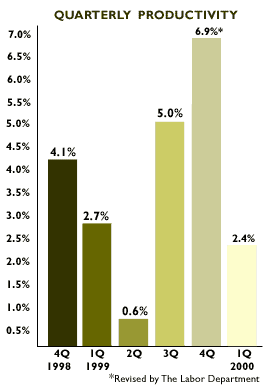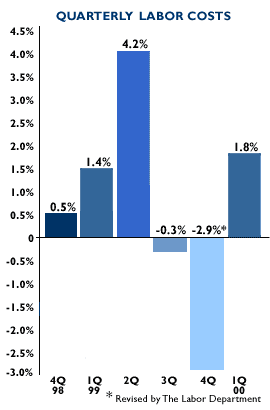NEW YORK (CNNfn) - U.S. worker productivity rose at a slower-than-expected rate in the first quarter while wage costs showed surprising strength, the government said Thursday -- evidence that the economy's best years of red-hot growth and low inflation could be nearing an end.
Productivity, a measure of worker output per hour, rose at an annual rate of 2.4 percent in the first three months of 2000, the Labor Department said. That's below the 3.5 percent gain expected by analysts surveyed by Briefing.com, and well under the upwardly revised 6.9 percent surge in the fourth quarter.
And labor costs -- a measure of what companies spend on workers -- jumped 1.8 percent. The first increase since the second quarter of 1999 was well above the 1.0 percent jump that Wall Street expected. It also counters the revised 2.9 percent decline in the final three months of last year.
News of slowing productivity gains, coupled with rising wages, sparked concern among economists wary that inflation, long contained, may be emerging.

"We are not going to see the strong increases in productivity that we've become accustomed to and I think we're at that point now and that's the message in these numbers," Wayne Ayers, chief economist at Fleet Boston, told CNNfn's market coverage.
Asked about the jump in labor costs, Ayers said. "I think it tells us that the best news on inflation is behind us."
The inflation-sensitive bond market agreed. The price of Treasury securities fell as the data hit the wires, sending yields, which move in the opposite direction, higher.
A new model?
Economists say the rise in worker productivity over the last year, much of it driven by new technology, has kept inflation under wraps. Rising efficiency can improve company profit, keeping corporations from passing costs on to customers, triggering inflation.
Alan Greenspan, the chairman of the Federal Reserve, has touted this surge in productivity, partially crediting it with pushing the economy into a record 110th month of expansion that has come without any significant rise in prices.
But Thursday's news puts a kink in that model. With labor costs rising and productivity slowing, inflation could rise, putting more pressure on the Federal Reserve to aggressively raise interest rate later this month.
Fleet Boston's Ayers predicts the Fed, the nation's central bank, will tighten credit by half a percentage point - an aggressive move following five smaller increases.
In contrast, Alan Kral, portfolio manager at Trevor Stewart Burton & Jacobsen, said the Fed should take that kind of step, but probably won't. He shared his thoughts with CNNfn's Before Hours. (WAV 510K) (AIFF 510K).
Part of a trend
Thursday's inflation suggesting data is not an aberration. Just last week, first quarter employment costs for companies showed their strongest jump in more than 10 years, and prices surged. And gross domestic product, the broadest measure of goods and services produced, advanced at a 5.4 percent pace in the period.
The Federal Reserve raised interest rates five times since last June, in a bid to slow the economy and pre-empt rising inflation. But tighter credit has had little apparent effect. Consumer spending is strong, home sales are buoyant and factory orders have surged.
Thursday's data, which came 24 hours ahead of April's anxiously awaited jobs report, was the first read on first-quarter productivity. The figures will be revised twice.
Still, Stan Shipley, senior economist at Merrill Lynch, said the wage gains, taken on a year-to-year basis, are not that significant. And the big picture on worker output still looks good. 
"The productivity story remains intact," Shiply told Reuters. "There is still no real wage pressure going on here. On a year-over-year basis, unit labor costs are still up only 0.7 percent, and you can't get real wage pressures with that."
Claims rise
A separate report from the Labor Department Thursday did little to alter the picture economic strength.
The number of Americans filing new claims for unemployment benefits rose to 303,000 for the week ended April 29. Though higher, the figure still is consistent with the tight labor markets and low unemployment that have existed for years.
Economist expect few changes in April's jobs report, due Friday. According to a survey by Briefing.com, the unemployment rate is seen falling to 4.0 percent from 4.1 percent in March. The survey also forecast 325,000 new jobs were added to the economy last month, down from 416,000 in the prior period. 
|

